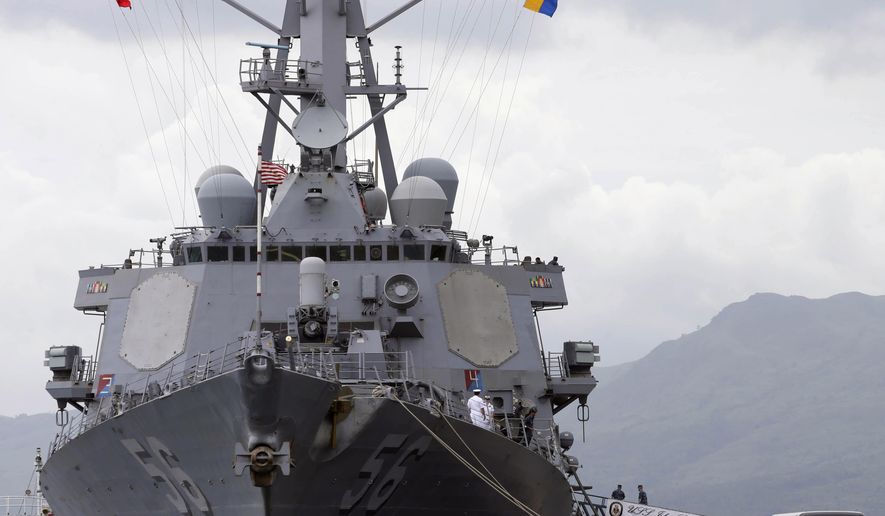The Pentagon and Russian defense ministry traded testy exchanges Tuesday after the USS John S. McCain sailed through a disputed section of the Peter the Great Bay in the Sea of Japan that the Kremlin has claimed since the days of the Soviet Union.
The Russian destroyer that threatened to ram the McCain as it carried of the sovereignty-challenging freedom of navigation operation had a similar close-call last year with another U.S. vessel operating in the Philippine Sea.
The U.S. Navy routinely conducts what it calls “FONOPs” in the South China Sea, where Washington and nations around East Asia have challenged China’s expansive territorial claims. But the mission this week into the bay provoked an unusually sharp exchange.
“These waters are not Russia’s territorial sea,” U.S. Navy officials said in a statement. “The United States does not acquiesce in Russia’s claim that Peter the Great is a ’historic bay’ under international law.”
TASS, the official Russian news agency, said the McCain violated Russia’s territorial waters by going more than a mile past the maritime border. The Russian Navy’s Admiral Vinogradov anti-submarine destroyer notified the U.S. ship that it faced being “forced out of the country’s territorial waters in a ramming maneuver.”
The Russian Navy claimed the Admiral Vinogradov “stopped” the McCain, which then returned to international waters. U.S. Navy officials called the Russian statement “false.”
“USS John S. McCain was not ’expelled’ from any nation’s territory. McCain conducted this FONOP in accordance with international law and continued to conduct normal operations in international waters,” U.S. officials said.
The same Russian ship was involved in a similar close call in June 2019 with the USS Chancellorsville, a guided missile cruiser operating in the Philippine Sea. According to the U.S. Navy, the Admiral Vinogradov came up from behind then suddenly accelerated and moved to the right of the U.S. ship as it was recovering helicopters. The Russian destroyer got within 50 to 100 feet of the American vessel.
“This unsafe action forced Chancellorsville to execute all engines back full and to maneuver to avoid collision,” U.S. Navy officials said. “We consider Russia’s actions during this interaction as unsafe and unprofessional.”
Russia denied its ship was at fault for the near collision, telling TASS the USS Chancellorsville suddenly changed course and crossed over in front of the Admiral Vinogradov, forcing it to carry out an “emergency maneuver.”
Brent Sadler, a senior fellow for naval warfare and advanced technology at the Heritage Foundation, said he wouldn’t be surprised if the incident reflected Russia’s desire to show the U.S. they are also a Pacific power and, like China, willing to push back against the traditional dominant position of the U.S. Navy in the region.
“The Russians and the Chinese are also due to renew their strategic partnership,” Mr. Sadler said. “I’m pretty sure there’s a connection there.”
The U.S. regularly conducts freedom of navigation missions in the western Pacific to dispute excessive claims by several countries, especially China in recent years. Analysts say the exercises are critical to upholding international rule of law in the face of growing authoritarian challenges.
“Such excessive claims are a threat to all who rely on freedom of navigation and Washington should seek to assemble the largest coalition of allies and partners possible to defend a free, open and inclusive Indo-Pacific,” said Bradley Bowman, senior director of the Center for Military and Political Power at the Foundation for Defense of Democracies.
There have been an increasing number of incidents with Russia’s Navy. In January 2020, an unidentified Russian Navy ship “aggressively approached” the USS Farragut while on routine operations in the North Arabia Sea. The Farragut sounded five short blasts, the international maritime signal for danger of a collision, and told the Russian ship to change its course.
“The Russian ship initially refused but ultimately altered course and the two ships opened distance from one another,” U.S. Navy officials said.
Brad Martin, a military analyst with the RAND Corporation, said there was no evidence the USS McCain was operating within internationally recognized Russian territory. He said these dangerous incidents are not something a Russian captain would decide to do on his own accord.
“It’s a policy statement. They want to make a point that they’re a great power and they can’t be overrun,” Mr. Martin said. “It’s more theater than anything.”
• Mike Glenn can be reached at mglenn@washingtontimes.com.




Please read our comment policy before commenting.